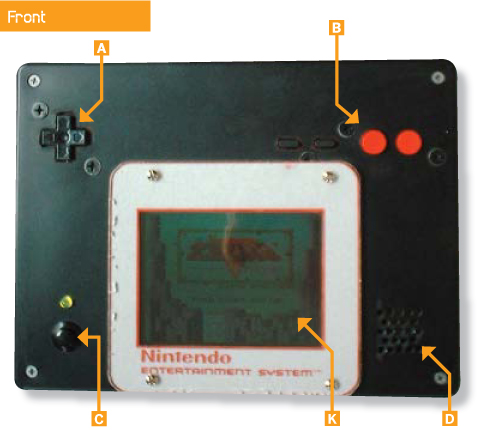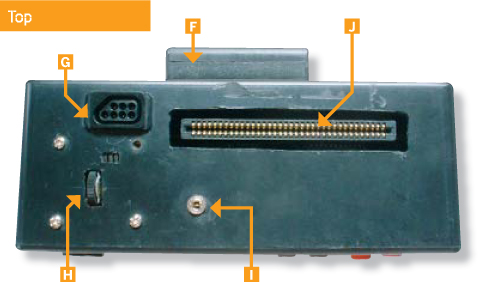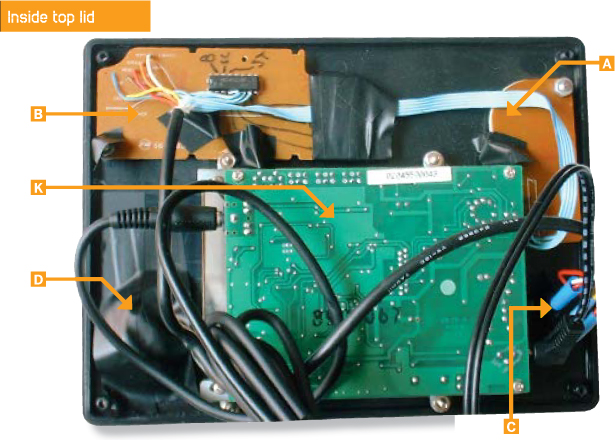GAME SYSTEMS TO GO
Portabilizers take apart video game systems and turn them into portable gaming units.
Benjamin J. Heckendorn hacks video games, in the most literal sense. The 29-year-old from Verona, Wisc., disassembles video game systems, cuts apart their circuit boards within, rewires them, and stuffs them into smaller, custom-made casings. Adding battery power systems and an LCD display, he transforms them into portable gaming units.
Four years ago, while employed at a company that had computer-controlled machining equipment, work turned to inspiration as he fashioned out a handheld casing to contain the circuitry of an Atari 2600 (also known as the Atari Video Computer System; see MAKE Volume 02, page 192). “I thought it would be a cool project in the memory of the old Atari 2600,” he recalls.
Heckendorn’s portable 2600 was somewhat clunky, with a tiny LCD screen (cribbed from a handheld TV) and woodgrain exterior that evoked the original design styling of the 2600. But it had an antiquated, retro-cool charm about it. When Heckendorn debuted his creation in 2001 on the internet, it caused a buzz in the classic video games community. Over time, he produced several refined versions of the device, and sold a number of them.
Other people, inspired by his work, made their own game portables — many out of systems besides the Atari 2600. An online community centered on the “portabilizing” of video game consoles emerged. Heckendorn himself turned other game consoles into handhelds. (Most recently, he constructed a portable PlayStation 2.)
His hobby has evolved into a book that was released in early 2005, Hacking Video Games: A Complete Guide for Turning Your Old Game Consoles Into Awesome New Portables. A do-it-yourself guide, the book features eight pre-designed projects the reader can build. Systems covered include the Atari 2600, Nintendo Entertainment System, Super Nintendo, and PlayStation 1.
Don’t try to convince Heckendorn and his fellow “portabilizers” that nowadays one can simply emulate many of the classic video game consoles on a PDA or handheld computer. To them, the guts of the old systems are what make their hand-built gaming portables unique. “The best thing about using original hardware is that it makes for a more interesting story,” says Heckendorn. “The fact that original parts are still used is intriguing to people.”
Portabilizing Your Video Game System: A Primer
Thinking about giving your old video game system a second life as a portable? Here are five important points to keep in mind for portabilizing it:
Wiring
In order to pack the original circuit boards of a video game system into a smaller case, the beginning work typically involves sawing apart the boards and reconnecting the circuit pathways with wires. “It helps to be good at soldering, since a lot of the connections a person needs to make can be quite small and close together,” notes Heckendorn.
Tighe Lory says once he figured out how to make his 2½ lb. portable version of the Nintendo Entertainment System (NES), the actual construction of the gaming device was simple. More than a hundred people have asked him if they could buy his portable NES, but he isn’t selling. He wants people to make one on their own.
Anatomy of a Homebrew Portable Gaming Device: The NES Portable
A. Joypad
B. Control buttons
C. Reset button
D. Speaker
E. External power jack, designed for the standard 10V GameGear adapter
F. 8 AA battery pack
G. Player 2 controller port
H. Volume control
I. AV out, for playing on a TV. Uses a stereo 1/8" jack to male RCA plugs.
J. Cartridge slot
K. Screen
L. Power on/off




Photography by Tighe Lory
Erik Zuroski, a 21-year-old computer engineering student from Milwaukee, Wisc., recalls wrangling with wiring as the biggest problem he faced when turning a PlayStation 1 into a portable. A single wire may not seem to take up a lot of precious volume inside a case, but they add up, and can become a frustrating, springy mess. He recommends, “Make sure to leave yourself enough room for wiring. It might make the final product a little bit bigger, but it will save you hours of frustration.”
Video Output and Display Screen
Pulling a video signal off of an old video game system and connecting it to a modern-day LCD screen may require the construction of additional circuits.
Says Tighe Lory, a 29-year-old programmer from Richmondville, N.Y., who made a portable Nintendo Entertainment System: “I had to create a new circuit board that amplifies the weak composite video signal after I removed the RF modulator from the NES.”
Heckendorn warns that taking apart a miniature television, from which to cannibalize the LCD screen, can pose another challenge.
“Some of the pocket TVs have strange internals, like multiple interconnected circuit boards instead of just one and weird [screen] lighting schemes,” he explains.
Power
The power requirements for a video game system, especially that of modern consoles, can be daunting. Lory’s portable NES runs for four hours on eight AA batteries — and that is considered impressive in this hobby scene.
Because a video game system’s power regulator is often situated on the periphery of its circuit board, it’s usually the first component to be removed and discarded. Still, Heckendorn says, “Don’t over-power the unit. Most systems need the power to be regulated before using it.”
Case Design
While most people don’t have access to machining equipment like Heckendorn did, it is possible to work with plastic. Design your portable’s casing with a CAD program and upload the file to a rapid prototyping firm, a company that will manufacture your case. (Expect to spend about $300 per case when using such a service.)
“Stereolithography is a very expensive technology, but it is the only way to give yourself the freedom of creating your vision,” says Brian Gardiner, a 27-year-old tech help analyst from Rocklin, Calif. He created a portable PS One with an especially slick-looking case that looks like something Sony itself might have designed. “To me, the appearance of my device was just as important as the functionality.”
Don’t rule out the possibility of using electronics cases from unwanted equipment either.
Cost
Expect to spend $200 or more for all the necessary parts. (The bulk of this goes to the display screen and battery.) If you choose to custom-design a handheld case for a more professional final product, the cost can go up to $600 and quite possibly more. For that price, you can buy a Nintendo DS and a library of games.
To the portabilizers, the price is worth it. “You don’t do a project like this to save money,” says Lory. “I really love the NES, and it was fun to take one apart and make it better than it was before, and breathe new life into it.”
Howard Wen is a freelance writer who has written for salon.com, oreillynet.com, playboy.com, and Wired, among others.
Make: Projects
Scare the kids in your neighborhood. Use that extra VCR to feed your pets and give you a weekend away (now that the neighborhood is out to get you). Then build a glowing potato cannon; maybe you can use it to impress the neighbors and get back on their good side.

Haunted House Controller

VCR Cat Feeder

Night Lighter 36
